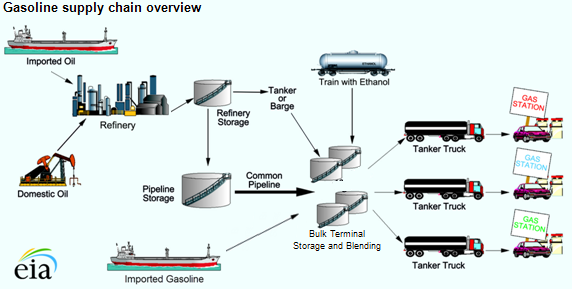
Weather and other events can cause disruptions to gasoline infrastructure and supply

The gasoline supply chain has five main parts: producing or importing crude oil; importing gasoline; refining the crude oil into gasoline; blending gasoline with ethanol at distribution terminals; and selling the gasoline at retail stations. Between each part, various storage and distribution logistics steps are involved to move and store both crude oil and gasoline. Disruptions can affect any part of the supply chain, and during major disruptions such as hurricanes or power outages, the Department of Energy issues situation reports to provide information about a disruption's effect on gasoline supply and other energy infrastructure and supply issues.
Domestic Production
Supplies of domestic crude oil are affected whenever offshore platforms stop producing crude oil because of unsafe operating conditions caused by weather. High winds and rough seas that come with hurricanes often cause offshore platforms to shut in production. Examples of times when domestic crude oil supply was affected include hurricanes Ike and Gustav in 2008.
Imports
Supplies of seaborne imported gasoline, which are mostly gasoline blending components, and imported crude oil are affected whenever U.S. ports are closed. Hurricanes in the Gulf of Mexico and along the East Coast often cause ports to close because of unsafe shipping conditions, loss of power, or both. Examples include Hurricane Katrina, which damaged and closed the Port of New Orleans in 2005, and Hurricane Sandy in 2012, which closed the Port of New York. Both of these ports are major entry points for either crude oil or gasoline imports.
Refining
Refineries manufacture crude oil into gasoline and other petroleum products. Hurricanes can result in flooding that damages refining equipment or causes power outages, preventing refineries from operating. When refineries do not operate, total U.S. gasoline production can decline and affect supplies of gasoline.
Distribution and Storage
Pipelines, Rail, Barge
Crude oil is moved by rail and pipeline from production areas to crude storage terminals where it is held until it can be refined into gasoline. Pipelines, barges, and tankers move gasoline to product terminals where it is stored before being blended with ethanol for end-use. Ethanol for blending into gasoline is typically transported by rail. Areas of the nation that receive crude oil and gasoline via pipeline can become supply-constrained when pipelines cannot operate because of power outages or other disruptions. When gasoline or crude storage terminals lose power, supply can become constrained because pipelines and barges have no way to load or discharge product. Barge traffic may also be disrupted when the water levels of rivers are low, when harbor waters freeze, or when ports are closed. Rail shipments of ethanol might be affected by disruptions at terminal rail loading facilities. Supply of ethanol can be affected by droughts as was seen in the summer of 2012.
Trucks
Gasoline is sent to terminals for storage until it is needed at retail outlets. At the storage terminal, gasoline is blended with ethanol and loaded into tanker trucks to be delivered to the retail outlets. If terminals do not have power, tanker truck loading is disrupted. Blizzards can also cause disruptions if trucks are not able to transport gasoline from terminals to gas stations because of poor road conditions. Distribution from terminals was a problem after Hurricane Sandy in 2012.
Retail
The retail station is the final step in the gasoline supply chain. As with other parts of the gasoline supply chain, retail outlets are affected by power outages. Some states have enacted laws requiring backup generators at certain retail stations. In addition, disruptions in earlier steps in the supply chain affect retail outlets by limiting the availability of gasoline supply.